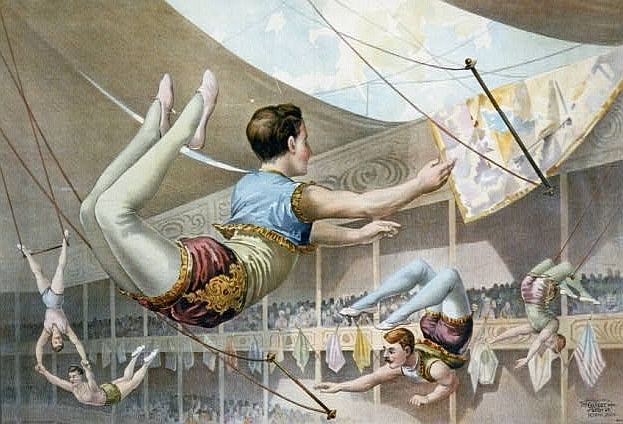 | ||
The flying trapeze is a specific form of the trapeze in which a performer jumps from a platform with the trapeze so that gravity makes the trapeze swing.
Contents
The performance was invented in 1859 by a Frenchman named Jules Léotard, who connected a bar to some ventilator cords above the swimming pool in his father's gymnasium in Toulouse, France. After practicing tricks above the pool, Leotard performed his act in the Cirque Napoleon (now known as the Cirque d'hiver). The traditional flier's costume, the leotard, is named after him.
Trapeze acts
In a traditional flying trapeze act, flyers mount a narrow board (usually by climbing a tall ladder) and take off from the board on the fly bar. The flyer must wait for a call from the catcher to make sure he or she leaves at the correct time. Otherwise, the catcher will not be close enough to the flyer to make a successful catch. The flier then performs one of many aerial tricks and is caught by the catcher, who is swinging from a separate catch bar. Once in the catcher's hands, the flyer continues to swing and is thrust back toward the fly bar in a maneuver called a "return". A return could consist of some kind of twist back to the bar, an "angel" (when the catcher holds the flyer by the feet and one arm), or any other trick that a flyer can think of to get back to the bar. Once back to the fly bar, the flyer can return to the board, and another flyer takes a turn.
Innovative trapeze
Although many people define a flying trapeze act as an act involving two trapezes and a catcher, as of 2008, many innovative styles of flying trapeze have been performed in circuses all over the world, such as Cirque Du Soleil, The Flying Farfans, and The Flying Caceres. Cirque Du Soleil's La Nouba features a bar-to-bar flying trapeze act, and Cirque Du Soleil's Corteo presents a high-flying act quite similar to flying trapeze, but without bars. The flyers fly from one catcher to another in an innovative adagio-influenced aerial act. Still other flying trapeze acts focus on high-flying aerial tricks from the flyers, but perform their release tricks to the net, rather than to catchers. also
Safety
In the early years of young Mr. Leotard's performances, the flying trapeze did not have the safety net as is typically seen today. He would perform over a series of mattresses on a raised runway to give the audience a better view of his tricks, or "passes".
Most modern flyers start out wearing a safety harness, while a trainer on the ground controls the lines and would pull them if the flyer is in a dangerous situation. Pulling on the lines will suspend the flyer in the air, and letting go of the lines slowly will bring the flyer to the ground safely. Once a flyer has mastered a particular trick, they will take off the safety harness. Every safe flying trapeze rig has a large net underneath the rig. Many flyers in the circus do not start out using safety belts. Those flyers who are not wearing safety harnesses learn how to fall safely into the net in case they miss a catch or unexpectedly fall off the bar or off the catcher.
Several risky flying trapeze acts have been performed without safety nets in earlier circus days, but it would be rare to find this kind of act today, as most flying trapeze acts are performed between 20 and 40 feet above the ground.
Terminology
Tricks
Below is a list of flying trapeze tricks that can be thrown to a catcher:
These are tricks performed bar to bar:
These are tricks that can be performed without a catcher:
Returns:
